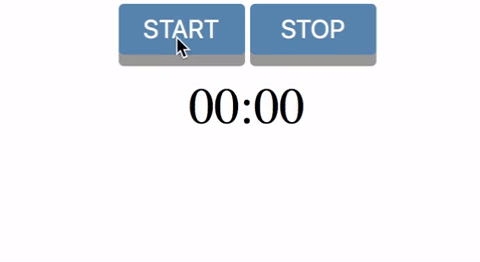一个mm:ss计时器C
尝试在C中制作一个以mm:ss格式计数的计时器,我不一定需要打印该值,只要有它存在以供参考即可。
这个想法是一个青少年设备上的“已用时间”时钟,计时器每经过一秒钟便会增加1秒,即60秒,分钟计时器会增加1,秒计时器会重置为0。计时器在后台运行,每秒更新一次,作为一种连续的秒表。
类似于下图,但是计时器不会随意启动或停止,它在程序初始化时启动,只需每秒增加一次计数器,不需要转换分钟即可达到99,因为这个时候程序应该已经结束了。
一个例子是一个时钟,显示从开始游戏关卡以来所经过的时间,向用户显示他们花了多长时间来完成游戏关卡。
我在下面进行了介绍,但是由于我不熟悉基于C和C的语言的工作方式,因此不确定自己是否朝着正确的方向前进。
int minutes = 0;
int seconds = 0, trigger = 1000;
clock_t start = clock();
do {
if(seconds == 60) {
seconds = 0;
minutes += 1;
}
clock_t difference = clock() - start;
seconds = difference * 1000 / CLOCKS_PER_SEC;
i++;
} while ( seconds < trigger );
例如,说x秒过去了;
-
89秒(1分9秒)
Time: 01:19 -
360秒(6分钟0秒)
Time: 06:00 -
27秒(0分钟27秒)
Time: 00:27 -
4893秒(81分33秒)
Time: 81:33
计时器应返回与上述类似的结果。
Windows系统。
有人可以帮忙吗?您可以组成所需的任何变量或任何变量,因为据我所知,我所做的甚至都无法做到。预先感谢。
2 个答案:
答案 0 :(得分:1)
可以使用Teensy系统通过其溢出和中断来启动计时器。下面的代码将设置并启动一个将递增计数的计时器。一个结构用于初始化一个布尔值(程序中可能有其他事情),该布尔值可用于控制计时器的溢出是否计数,有效地暂停计时器。
绘制字符串的功能
// Render a string of printable ASCII characters into the screen buffer.
// Parameters:
// x - The horizontal position of the top-left corner of the displayed text.
// y - The vertical position of the top-left corner of the displayed text.
// character - The ASCII code of the character to render. Valid values range from
0x20 == 32 to 0x7f == 127.
// colour - The colour, FG_COLOUR or BG_COLOUR. If colour is BG_COLOUR,
the text is rendered as an inverse video block.
void draw_string(int top_left_x, int top_left_y, char *text, colour_t colour) {
// Draw each character until the null terminator is reached
for ( uint8_t x = top_left_x, i = 0; text[i] != 0; x += CHAR_WIDTH, i++ ) {
draw_char(x, top_left_y, text[i], colour);
// Add a column of spaces here if you want to space out the lettering.
// (see lcd.c for a hint on how to do this)
}
}
下面是格式化函数,使用上述函数绘制字符串,该格式化函数用于获取mm:ss布局
// a formatting function to assist with printing to the screen
void draw_formatted(int x, int y, const char * format, ...) {
va_list args;
va_start(args, format);
char buffer[1000];
vsprintf(buffer, format, args);
draw_string(x, y, buffer, FG_COLOUR);
}
排序格式后,应创建一个结构以初始化操作计时器所需的值,并启动计时器
// initiates a struct for the timer, which includes a minute, second and
// validator accessed using tim
struct val_store {
bool timer_validator;
uint8_t time_passed
uint8_t min;
uint8_t sec;
} tim;
// initiates timer parameters, essentially setting up the timer to be able to function,
// sets timer to begin, this should be included in the initial setup of a program
TCCR1A = 0;
TCCR1B = 2;
TIMSK1 = 1;
sei();
tim.timer_validator = true;
下面是计时器的隐藏部分,这是心脏,它创建了作为整个问题基础的值,这非常重要,除非TCCR1A,TCCR1B,TIMSK1和sei(),否则它将不起作用预先初始化,其值可以分别为0、2、1,但是,下面的计时器中使用的值必须使用位图进行相应调整
// Create a volatile global variable called over_flow_count
volatile unsigned int over_flow_count = 0;
// interrupt service routine to process timer overflow
// interrupts for Timer 1.
ISR(TIMER1_OVF_vect) {
// checks if timer is active or not
if (tim.timer_validator) {
over_flow_count++;
}
}
// elapsed time since program start
// use float instead of double to save memory
float elapsed_time(void) {
float current_time = (float)
( ( over_flow_count * 65536.0 + TCNT1 ) * 8.0 / 8000000 );
return current_time;
}
最后,与上述计时器配合使用以生成mm:ss格式的输出的代码很简单,这是因为上面的计时器完成了所有工作,剩下的只是格式化。传递的时间调用了先前创建的函数,即传递的总时间范围,然后使用除法和取模来找到min和sec,并使用先前制作的格式化函数对其进行格式化
tim.time_passed = elapsed_time();
tim.min = time_passed / 60;
tim.sec = time_passed % 60;
draw_formatted(x, y, "Time: %02d:%02d", tim.min, tim.sec);
可以使用类似的方法创建暂停
if (BIT_VALUE(PINB, 0)) {
// buffer before and after to prevent a single press activating
// multiple instances of a joystick press, cheap interrupt
_delay_ms(250);
// pauses timer by setting the boolean to false, preventing the if statement passing
tim.timer_validator = false;
while(true) {
clear_screen();
#Put processes to occur while paused here
// checks to see if the pause should resume
if (BIT_VALUE(PINB, 0)) {
break;
}
// continue timer
tim.timer_validator = true;
// once again a buffer for good measure
_delay_ms(250);
}
如果正确创建了程序,则计时器应追溯更新! 希望对您有帮助!
相关包含,并非所有包含都可以使用。
// includes
#include <assert.h>
#include <avr/interrupt.h>
#include <avr/io.h>
#include <cpu_speed.h>
#include <math.h>
#include <stdarg.h>
#include <stdbool.h>
#include <stdio.h>
#include <stdlib.h>
#include <util/delay.h>
答案 1 :(得分:0)
不确定此处的用途,只是数秒,直到到达触发器,然后转换为mm:ss?您可以计算到达触发条件之前的秒数,并将触发条件表示为mm:ss,基本上是同一回事。
仅凭猜测,您正在寻找类似的东西吗?
unsigned int minutes = 0;
unsigned int seconds = 0;
unsigned int trigger = 360;
unsigned int elapsed_seconds = 0;
/* Count the seconds until #trigger seconds are reached (?)*/
clock_t start = clock();
do {
clock_t difference = clock() - start;
elapsed_seconds = difference * 1000 / CLOCKS_PER_SEC;
/* Stop at trigger (?)*/
} while ( elapsed_seconds < trigger );
/* Express in minutes and seconds */
minutes = elapsed_seconds / 60;
seconds = elapsed_seconds % 60;
printf("Time: %02d:%02d\n", minutes, seconds);
- 我写了这段代码,但我无法理解我的错误
- 我无法从一个代码实例的列表中删除 None 值,但我可以在另一个实例中。为什么它适用于一个细分市场而不适用于另一个细分市场?
- 是否有可能使 loadstring 不可能等于打印?卢阿
- java中的random.expovariate()
- Appscript 通过会议在 Google 日历中发送电子邮件和创建活动
- 为什么我的 Onclick 箭头功能在 React 中不起作用?
- 在此代码中是否有使用“this”的替代方法?
- 在 SQL Server 和 PostgreSQL 上查询,我如何从第一个表获得第二个表的可视化
- 每千个数字得到
- 更新了城市边界 KML 文件的来源?
